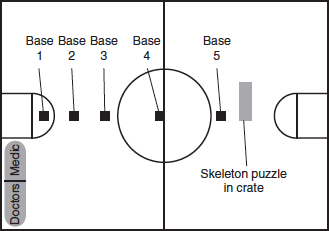Intermediate Team Building Challenges: Frankenstein Challenge
This is an excerpt from Team Building Through Physical Challenges-2nd Edition With Web Resource by Leigh Anderson,Daniel W Midura,Donald R Glover.
This beat-the-clock challenge reinforces the structure of the human anatomy. It uses the same skeleton equipment as General Hospital, Emergency Room does. We do not normally make the challenges competitive in nature, but part of the fun of this challenge is trying to do it as fast as possible.
Participants attempt to put together the skeleton puzzle in the shortest time possible. The team has to earn the right to put parts of Frankenstein together by successfully tossing and catching a deck tennis ring. Each time team members have successfully passed the ring, the team gets to add three more bones to Frankenstein. A minimum of seven trips of tossing the ring will be required to build Frankenstein. The group creates a system of tossing, catching, running, and building the puzzle.
Equipment
- One skeleton puzzle
- One deck tennis ring
- One storage crate or container
- Five indoor bases
Setup
Place the bases 10 to 15 feet (3.0 to 4.5 meters) apart in a straight line. Modify the distance depending on the age and ability of your students.
Five team members each stand on a different base. The remaining team members must be in the building area close to base 1. The storage crate holding the skeleton puzzle should be at the opposite end of the work area, or about 15 feet (4.5 meters) from base 5. See diagram.

Frankenstein setup.
Rules and Sacrifices
- Team members must toss the deck tennis ring from base 1 to base 2. The person on base 2 must catch the ring and successfully turn and toss it to the person on base 3. This process continues until the ring has traveled all the way to base 5 and back to base 1. If a team member drops the ring, it must be sent back to the team member who last tossed it.
- Once the ring gets back to base 1, the medic runs to the storage crate at the opposite end of the gym and brings back three bones. The medic cannot leave the building area (the lab) until the ring gets back to base 1.
- When the medic returns, he or she must give the bones to the doctors, who begin assembling the puzzle. When the doctors receive the bones, all players rotate positions. The medic goes to base 1, the person on base 1 goes to base 2, the person on base 2 goes to base 3, the person on base 3 moves to base 4, and the person on base 4 moves to base 5. The person on base 5 becomes a new doctor, and one of the doctors becomes the new medic. Team members cannot rotate positions until the medic returns to the building area with three bones.
- The ring must make seven successful round trips to get all the puzzle pieces to the building area. After the last medic has delivered the last three puzzle pieces, team members can hustle to the lab and confer about any changes they need to make to Frankenstein to make him complete. When they think that they have put Frankenstein together correctly, the last medic yells, “Lightning.” This is the signal to stop the clock. The instructor then checks the puzzle for accuracy. If the puzzle is correct, the time stands. If it is incorrect, the clock starts again as the team rearranges the bones.
This process continues until the team assembles Frankenstein correctly.
Possible Solutions
The team should communicate before the challenge starts about where teammates should position themselves to start the challenge. Certainly, a team would want the best catchers on the bases, and a teammate who is a good doctor should plan to rotate to the lab when most of the bones are there.
Conclusion of the Task
The group completes the task when the team assembles Frankenstein correctly and the clock stops.
Additions and Variations
- Allow team members to assign permanent roles so that they can match the team members' skills with the challenge.
- Lengthen or shorten the distance of the toss.
- Allow participants to bring back more or fewer bones to shorten or lengthen the time of the challenge.
Safety Considerations
This challenge presents no specific safety considerations other than the possibility that the deck tennis ring may hit someone who is not looking when a teammate tosses it.
More Excerpts From Team Building Through Physical Challenges-2nd Edition With Web ResourceSHOP

Get the latest insights with regular newsletters, plus periodic product information and special insider offers.
JOIN NOW


